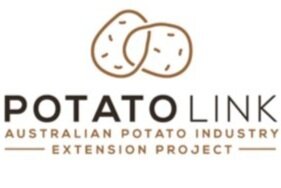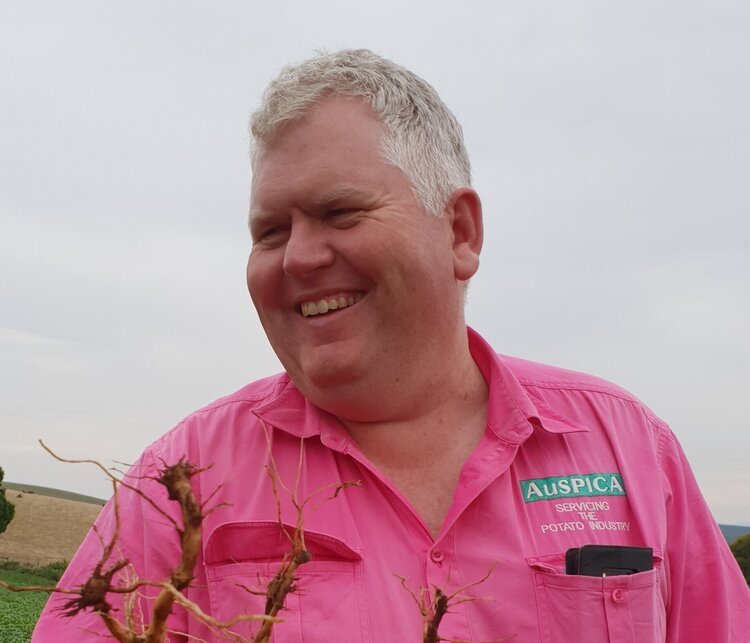Seed handling and cutting online training summary
At the recent PotatoLink seed handling and cutting online training session, Andy Robinson (NDSU/UMN) and Nigel Crump (AuSPICA and PotatoLink) led discussions with growers and industry members around seed quality, managing seed once physiological age is known, and the value of communication to ensure a good return on investment.
Participants listening to Andy speak about physiological age
Andy Robinson believes that in many ways potato production is like building a factory. We want to build the factory quick, and we want it to run long and efficiently. This is true for both seed and commercial production. There are many factors that go into the potato production factory, with seed being the foundation of the production line.
So, what characteristics define good quality seed? Some growers in the meeting mentioned that it was things you cannot see, seed that can handle storage well, seed that is free of disease and viruses, and seed that is fit for purpose.
But what actually defines fit for purpose? How do you know if your seed is fit for purpose? Knowing that the seed is certified as disease free is the best start, following by ensuring you have the right size of seed (smaller for whole, larger for cut), and visiting the site of the seed grower. Andy also highlighted that physiological age of the seed will determine its outcome and should be factored into decision making.
Physiological age is the internal age of the seed resulting from biochemical changes taking place in within the tuber - Andy Robinson
Underpinning all of the above is good communication between commercial growers, seed growers and seed stores.
When communication breaks down we can find ourselves in the Bermuda triangle of seed quality, according to Nigel Crump where quality can go missing.
‘The seed quality Bermuda triangle’ - Nigel Crump
Each point in this triangle has a role in ensuring seed is of a good quality. Certification, in the middle of the triangle ensures seed is free of diseases, however it does not account for other aspects such as physiological age. To reduce quality loss in the seed quality Bermuda triangle there needs to be good communication, data and information allowing for informed decisions.
Seed growers need to meet the needs of the buyer. Managing the spuds throughout the processes from growing to harvest and then to storage is key. Activities at this time can impact the seed but symptoms may not appear until later. Thought needs to be given to conditions at grading, for example what is the humidity and temperature? Bruising also needs to be minimised, at harvest, at grading and in store.
Some of the seed grower activities and things to monitor include:
Managing physiological age to meet the needs of the buyer
Managing skin set
Conditions at harvest
conditions at grading
contaniers for loading (bins, bulk bags)
timing of grading
General - Drops and bumps
Disease managment/seed treatments
Certification
While seed storage is important for maintaining seed quality, it will not increase it. The seed store is not a hospital. Measurement of conditions within the store are becoming easier as improved technologies make sensor equipment cheaper and more accessible. It also means that seed stores can have a better idea of what is going on throughout the store, for example, what is the CO2 at the top of the store? Is it the same as the bottom? What is the temperature at the door, and in the centre of the middle bin? Having access to these measurements allows stores to better ensure uniformity in their seed lots, resulting in better uniformity in seed quality.
Seed stores also need to manage
Conditions in the seed potato store
Uniformity of conditions in the store
Hygiene in stores
Timing of storage
Seed cutting (hygiene, post cutting management)
Seed buyers also need to ask questions to get an assessment of risk. How are the seed being transported? How are they being unloaded and has bruising been considered? If seed buyers are storing seed after buying, is the store on and ready for the tubers? Are they properly ventilated?
Other items that Seed buyers need to think about include:
Physiological age requirements for their commercial operations
Shipping time
How the seed will be unloaded on arrival (conditions and reducing bruising)
Seed treatments
Storage timing
Seed cutting (size, hygiene, post cutting management)
Planting conditions
When cutting, ensuring that tubers are cut cleanly and allowed to suberise properly is important.
During the session, growers in the call also raised the importance of managing seed when warming up for planting. Seed in different parts of the shed can experience different temperatures, impacting their physiological age and reducing uniformity.
Seed is a major investment in potato production. There is a lot that can influence the quality of seed, but there is also a lot that can be done to keep the seed uniform and fit for purpose. Communication is key, along all stages of the seed supply chain. Read the PotatoLink Seed Sourcing & Purchasing Checklist for more on what you can do when sourcing seed.
There will be a full write up of the event in the Spring PotatoLink magazine.
Other Resources
PotatoLink bruising fact sheet
PotatoLink bruising webinar
PotatoLink seed storage and physiological age webinar
PotatoLink seed storage and physiological age fact sheet
The presenters
Dr Andy Robinson (USA)
Extension Potato Agronomist and Associate Professor, North Dakota State University and University of Minnesota Department of Plant Sciences
Andy Robinson, an Idaho native, grew up farming in Parma, ID with his family. He received a bachelor’s degree from Brigham Young University and his master and doctorate degrees from Purdue University.
Robinson’s research and extension goals are to develop science-based solutions to address real-world problems in potato production, enabling producers to increase economic and environmental sustainability through improved crop management. Potato producers throughout the world can follow Dr. Robinson here.
His passion is potatoes. Robinson contributes regularly to the Valley Potato Grower writing “Andy’s Advice”. His work has taken him around the globe speaking, conducting research and providing education. This work has been acknowledged by being awarded the Spudman Emerging Leader Award, the Myron and Muriel Johnsrud Excellence in Extension Award, Communicator of the Year award from NDSU Extension. He enjoys traveling and spending time in nature with his wife, Michelle and five children.
Dr Nigel Crump
General Manager, Australian Seed Potato Industry Certification Authority (AuSPICA) and Regional Representative, PotatoLink.
Dr Nigel Crump is a potato pathologist with over 20 years’ experience working in the Australian potato industry. Nigel also oversees the day-to-day operation of the Toolangi Elite business which produces G0 potato mini tubers and tissue culture plantlets.
Nigel holds adjunct roles including Deputy Chair of the UN Economic Commission specialised section on seed potatoes.
Nigel was appointed as a director of the World Potato Congress Inc. Research includes involvement in international projects in Vanuatu, Ethiopia, Indonesia and New Zealand.




